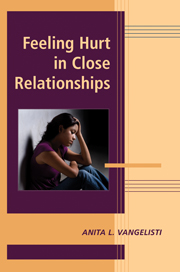Book contents
- Frontmatter
- Contents
- List of Contributors
- Foreword
- PART I INTRODUCTION
- PART II CONCEPTUALIZING HURT
- PART III HURTFUL ACTS
- 7 Rejection: Resolving the Paradox of Emotional Numbness after Exclusion
- 8 Conflict and Hurt in Close Relationships
- 9 When the Truth Hurts: Deception in the Name of Kindness
- 10 Affairs and Infidelity
- 11 Aggression, Violence, and Hurt in Close Relationships
- PART IV HURT IN RELATIONAL CONTEXTS
- PART V HURT IN APPLIED CONTEXTS
- Author Index
- Subject Index
- References
8 - Conflict and Hurt in Close Relationships
from PART III - HURTFUL ACTS
Published online by Cambridge University Press: 04 August 2010
- Frontmatter
- Contents
- List of Contributors
- Foreword
- PART I INTRODUCTION
- PART II CONCEPTUALIZING HURT
- PART III HURTFUL ACTS
- 7 Rejection: Resolving the Paradox of Emotional Numbness after Exclusion
- 8 Conflict and Hurt in Close Relationships
- 9 When the Truth Hurts: Deception in the Name of Kindness
- 10 Affairs and Infidelity
- 11 Aggression, Violence, and Hurt in Close Relationships
- PART IV HURT IN RELATIONAL CONTEXTS
- PART V HURT IN APPLIED CONTEXTS
- Author Index
- Subject Index
- References
Summary
According to Vangelisti (2007), “whenever two people communicate, they risk hurting each other” (p. 121). Such risk is elevated when the communication involves conflict. Interactions involving conflicts tend to be more arousing and to elicit more negative emotions than do other conversations (Levenson & Gottman, 1985). The heightened affective intensity associated with conflict provides abundant occasions for hurt feelings. Indeed, the apparent connection between conflict and hurt is strong enough that some scholars treat being hurt as synonomous with interpersonal conflict (e.g., Wainryb, Brehl, & Matwin, 2005). Other scholars simply assume that conflict is inherently hurtful; for instance, one study examining the “most frequently used strategies of relational conflict resolution” was titled “You always hurt the one you love…” (Fitzpatrick & Winke, 1979, p. 3).
Despite the belief that conflict and hurt are closely related, there is surprisingly little research that systematically examines their association. This lack of focus on hurt and conflict is remarkable given that other emotions, like anger, are frequently linked to conflict (e.g., Notarius, Lashley, & Sullivan, 1997). Clearly, addressing this gap in the literature could be useful, potentially answering questions such as “How can individuals make their conflicts less hurtful?” and “Can (and should) people prevent hurt feelings from leading to interpersonal conflicts?” A single chapter can only begin to address such questions, but our goals are (a) to adumbrate the research that does exist on conflict and hurt and (b) to provide an initial framework for thinking about how the hurtful aspects of conflict can be reduced.
- Type
- Chapter
- Information
- Feeling Hurt in Close Relationships , pp. 143 - 166Publisher: Cambridge University PressPrint publication year: 2009
References
- 5
- Cited by

